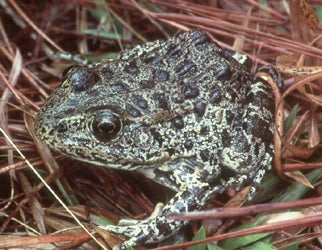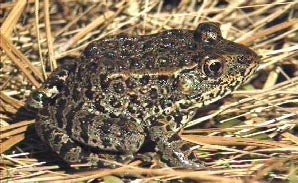OTHER NAMES:
Dusky Gopher Frog, Dusky Crawfish Frog, Dark Gopher Frog.
STATUS:
Gopher Frog: Endangered. Principally a Coastal Plain longleaf pine forest inhabitant, where 10 historic records exist. Subspecific allocation of Alabama populations is problematic; formerly considered R.c. sevosa, dusky gopher frog. Alabama's five extant breeding sites are in Escambia and Covington Counties. The only Ridge and Valley breeding pond (Shelby County) was drained for a subdivision in 1997, and a Barbour County breeding pond was destroyed by road construction. HIGHEST CONSERVATION CONCERN.
Mississippi Gopher Frog: Endangered/ Possibly extirpated. Recently described (2001) as western component of what had been considered R. capito sevosa (dusky gopher frog) from Mobile Bay to Louisiana. Currently known from a single population in Mississippi, but also recorded from Gulf Coast Flatwoods of Alabama (mouth of Dog River). Similar in appearance and habitat requirements to gopher frog. Secretive and difficult to survey. Listed as endangered by the U.S. Fish and Wildlife Service. HIGHEST CONSERVATION CONCERN.
DESCRIPTION:
Both species stout-bodied, large-headed frogs up to 10 centimeters (four inches) head-body length, with a thick ridge of skin extending down the back behind each eye. Toes taper to rounded points, snout is somewhat pointed, and back is rough-textured and warty. Lithobates capito differs from L. sevosa principally in color, with former generally a lighter gray or brown with dark blotches snd smaller dark markings as compared with an overall darker pigmentation and less distinct dorsal patterning in latter. Undersides of both species whitish with numerous small spots and vermiculations, but typically more conspicuous in L. sevosus. Inner surfaces of hind legs and adjacent belly portions of both species washed with yellow. Considerable variation in coloration and patterning often observed within populations. Males differentiated from females by smalle size and paired vocal sacs on either side of throat. The greenish yellow tadpole is large, full-bodied, long-tailed, and spotted over the upper surface and tail fin. Except in very latest stages of development, gopher frog tadpoles virtually indistinguishable from those of the leopard frog. Taxonomic history of gopher frogs is complex. Subsequent to original description of gopher frogs west of Mobile Bay as a distinct species (L. sevosa) (Goin and Netting 1940), those from that region have been at various times considered subspecies of both L. capito (as L.c. sevosa, dusky gopher frog) and L. areolata (as L.a. sevosa, dusky crayfish frog). A recent examination of genetic differences among gopher frog populations in several states revealed that the only known remaining population west of Mobile Bay (Harrison County, Mississippi) was distinct enough (in addition to aforementioned pigmentation differences) to justify resurrecting L. sevosus as a full species (Young and Crother 2001). Assuming Mobile Bay sperates L. sevosus on the west from L. capito on the east, gopher frogs that historically occurred in Mobile County probably are L. sevosa. Since the validity of the previously recognized subspecies of L. capito and zones of intergradation between them remain in question, for purposes of this account no subspecific designation is assigned to L. capito populations occurring in Alabama.
DISTRIBUTION:
The complex of gopher frog species that includes the gopher frog and the Mississippi gopher frog occurs from Louisiana to Florida and northward in the Coastal Plain to North Carolina (Altig and Lohoefener 1983). Two apparently disjunct populations, tentatively assigned to the gopher frog, are known from above the Fall Line: one in the Ridge and Valley of Shelby County, Alabama, another in the Interior Low Plateau of Coffee County, Tennessee. The distributions of the two species are not well known. The few Alabama records are from Mobile, Baldwin, Barbour, Escambia, Covington, and Shelby Counties (Mount 1975).
HABITAT:
Principally open longleaf pine-scrub oak forests developed on sandy soils, the favored habitat of the gopher tortoise in Alabama. Although highly terrestrial, also require isolated, temporary, wetland breeding sites. Adults live sometimes up to 1.6 kilometers (one mile) from breeding sites and spend days underground in tortoise burrows, mammal burrows, and root holes in rotting tree bases (Richter et al. 2001). At night, emerge to feed on insects and other small animals.
LIFE HISTORY AND ECOLOGY:
Breeding occurs usually in February and March in temporary ponds, but species may be able to breed any time of year following unusually heavy rains. Males emit a distinctive snoring call that occasionally can be heard up to 0.5 kilometers (0.3 mile) away, but some choruses are entirely submerged and so faint that a listener must be standing at the pond margin to hear the muffled calls (Jensen et al. 1995). Females may not breed every year, but lay hundreds of eggs when they do (Palis 1998). Tadpoles remain in ponds 90-120 days, and the small, metamorphosed froglets migrate to dry terßestrial habitats to mature.
BASIS FOR STATUS CLASSIFICATION:
The gopher frog is currently known to breed at only five isolated wetlands in southern Alabama. Two are on ConecuhNational Forest and three are on privately owned timber industry lands. A third pond on ConecuhNational Forest has been used when not stocked with fish. At least six historic sites have either been destroyed or could no longer be confirmed during surveys in the early 1990s, when the Alabama Natural Heritage Program investigated all historic sites and several dozen potential breeding ponds in seven counties. Last documented Alabamaoccurrence for the Mississippi gopher frog (in MobileCounty) is more than 80 years old (Loding 1922). Because gopher frogs breed in ephemeral ponds, reproduction fails in those years when ponds dry before metamorphosis. Local populations are therefore prone to extirpation following several consecutive dry seasons (Richter et al. 2003). Fragmentation of habitat has reduced or eliminated availability of nearby source populations for recolonization following local extirpation. Virtually all tadpoles in the only known Mississippi gopher frog breeding site succumbed to a newly discovered disease in 2003, the first year such a die-off was documented. The unidentified mesomycetozoan pathogen was first detected in bullfrog tadpoles from New Hampshire in 1999, and since has been associated with mass die-offs of larval ranid frogs from Minnesota and Virginia. It causes abnormalities of the liver, spleen, and kidneys (L. LaClaire, USFWS, pers. comm.). Because of the small number of populations, rapid deSline in amount and quality of breeding and nonbreeding habitat, the high probability of local extirpations, the new threat of disease, and their close association with the threatened gopher tortoise, both gopher frog species have been assigned the same Priority Designation. The Mississippi gopher frog was listed as endangered by the U.S. Fish and Wildlife Service in 2001.
Author: Mark A. Bailey and D. Bruce Means







